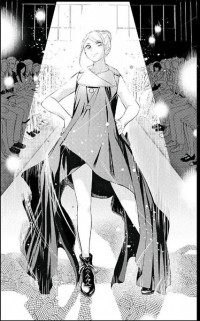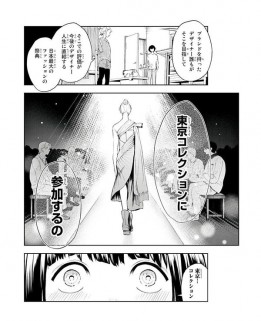Loading
Search
▼ Manga Realistically Portrays Fashion Industry
- Category:Other
The fashion industry is the setting of the manga “Runway de Waratte” (Smile at the runway), which is being serialized in Shukan Shonen Magazine, a weekly manga magazine for boys.
It is very rare for such a magazine to carry a work about fashion.
The manga, which started its run in May last year, is attracting a lot of attention thanks to its realistic depiction of fashion shows and exhibitions.
The manga has two protagonists, both high school students: Chiyuki Fujito and her male classmate, Ikuto Tsumura.
Chiyuki aspires to become a runway model, and Ikuto wants to become a fashion designer, although they both have their setbacks. Chiyuki is only 158 centimeters tall, while Ikuto comes from a poor family. But they motivate and inspire each other and go forward, refusing to give up their dreams.
The compilation of the manga, in four volumes so far, has sold more than 280,000 copies.
“It’s an unusual subject for a boys’ manga magazine, but it’s gaining far more popularity than expected,” said the manga’s editor at Kodansha Ltd., which publishes the magazine.
The manga was also short-listed for the prestigious Manga Taisho (Cartoon grand prize) 2018 awards.
It is very rare for such a magazine to carry a work about fashion.
The manga, which started its run in May last year, is attracting a lot of attention thanks to its realistic depiction of fashion shows and exhibitions.
The manga has two protagonists, both high school students: Chiyuki Fujito and her male classmate, Ikuto Tsumura.
Chiyuki aspires to become a runway model, and Ikuto wants to become a fashion designer, although they both have their setbacks. Chiyuki is only 158 centimeters tall, while Ikuto comes from a poor family. But they motivate and inspire each other and go forward, refusing to give up their dreams.
The compilation of the manga, in four volumes so far, has sold more than 280,000 copies.
“It’s an unusual subject for a boys’ manga magazine, but it’s gaining far more popularity than expected,” said the manga’s editor at Kodansha Ltd., which publishes the magazine.
The manga was also short-listed for the prestigious Manga Taisho (Cartoon grand prize) 2018 awards.
The author, Kotoba Inoya, won the top prize at Kodansha’s award for newcomer manga artists in 2015. “Runway de Waratte” is the debut work for Inoya, whose gender is kept secret.
The manga artist has never studied fashion formally but has always liked clothes. The author draws attire in manga based on research and with guidance from a fashion specialist.
Asked for the reason for choosing fashion as the subject matter, Inoya explained, “Unlike in sports, a man and a woman can compete with and encourage each other [in fashion]. It’s also great that clothes are everyday items for everyone.”
The author’s pursuit of realism is one of the factors that have made this manga so popular. Inoya interviewed designers, models and people working at dressmaking schools.
As a result, the manga gives detailed portrayals of the texture of materials and the silhouettes of dresses as well as showing how staff members speedily prepare for runway shows backstage.
Most of the magazine’s readers are boys who are not especially familiar with high fashion. The manga stands out in its ingenious efforts to make it interesting to that audience.
For example, those readers tend to find it easier to immerse themselves in a story when there is a clear goal, such as qualifying for the national high school baseball tournament. Yet goals in the fashion industry are more difficult for people outside to see.
Therefore, the manga introduced the Tokyo Collection at an early stage as a dream goal for the two central characters, giving shape to a heartwarming drama of them growing up.
The manga also contains notes explaining fashion terms, which helps readers new to the field understand the story.
At a time when fast fashion is so dominant, it is easy to forget that behind the production of expensive, high-quality clothes are designers’ high skills and struggles.
“I’d like to put across the profound appeal of fashion, and I hope as many people as possible will develop a love of clothing,” Inoya said.
The manga artist has never studied fashion formally but has always liked clothes. The author draws attire in manga based on research and with guidance from a fashion specialist.
Asked for the reason for choosing fashion as the subject matter, Inoya explained, “Unlike in sports, a man and a woman can compete with and encourage each other [in fashion]. It’s also great that clothes are everyday items for everyone.”
The author’s pursuit of realism is one of the factors that have made this manga so popular. Inoya interviewed designers, models and people working at dressmaking schools.
As a result, the manga gives detailed portrayals of the texture of materials and the silhouettes of dresses as well as showing how staff members speedily prepare for runway shows backstage.
Most of the magazine’s readers are boys who are not especially familiar with high fashion. The manga stands out in its ingenious efforts to make it interesting to that audience.
For example, those readers tend to find it easier to immerse themselves in a story when there is a clear goal, such as qualifying for the national high school baseball tournament. Yet goals in the fashion industry are more difficult for people outside to see.
Therefore, the manga introduced the Tokyo Collection at an early stage as a dream goal for the two central characters, giving shape to a heartwarming drama of them growing up.
The manga also contains notes explaining fashion terms, which helps readers new to the field understand the story.
At a time when fast fashion is so dominant, it is easy to forget that behind the production of expensive, high-quality clothes are designers’ high skills and struggles.
“I’d like to put across the profound appeal of fashion, and I hope as many people as possible will develop a love of clothing,” Inoya said.
- April 28, 2018
- Comment (1)
- Trackback(0)




google Web Site- September 26, 2020